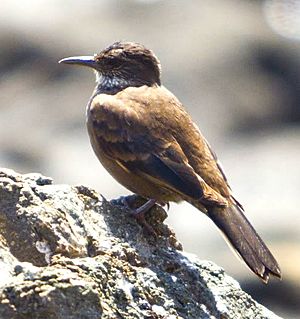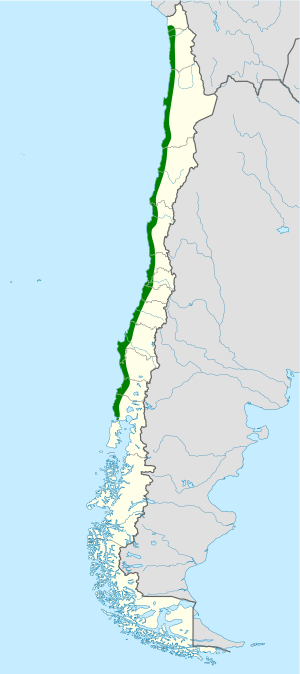Chilean seaside cinclodes facts for kids
Quick facts for kids Chilean seaside cinclodes |
|
|---|---|
 |
|
| Conservation status | |
| Scientific classification | |
| Genus: |
Cinclodes
|
| Species: |
nigrofumosus
|
 |
|
| Synonyms | |
|
|
The Chilean seaside cinclodes (scientific name: Cinclodes nigrofumosus) is a type of bird. It belongs to the Furnariidae family, also known as the ovenbirds. This special bird lives only on the rocky coasts of Chile. It is found nowhere else in the world. Some experts think the Peruvian seaside cinclodes is a close relative. However, these two birds live in different areas and do not meet.
Contents
What Does the Chilean Seaside Cinclodes Look Like?
This bird grows to be about 27 centimeters (11 inches) long. Its upper body is mostly a dark, sooty brown color. It has a thin, whitish stripe above its eye. The tips of its outer tail feathers are also pale. When it flies, you can see a reddish-brown bar on its wings.
The chin, throat, and sides of its neck are white. Its chest and belly are brown with white streaks. The bird has a dark gray beak that is slightly curved. Its legs are rather short and dark gray.
Where Does This Bird Live?
The Chilean seaside cinclodes is a bird that lives only in Chile. It prefers to live along the coast. You can often find it on rocky shores with large boulders and tidepools. Its home range stretches from the city of Arica in the north all the way to Valdivia in the south.
How Does the Chilean Seaside Cinclodes Live?
These birds often bob their tails as they walk along the shore. They have a very loud, trilling song. They often sing from the top of a large rock. Sometimes, they even spread their wings while singing.
Chilean seaside cinclodes usually search for food alone or in pairs. They look for small crustaceans and other tiny invertebrates along the shoreline. They are brave hunters, often searching for food in places where waves crash. Breeding season for these birds is in August and September.
They build their nests in cracks in rocks. Sometimes, they dig a hole in an earth bank to make a nest. The nest is made from grasses. The female bird lays two to four white eggs.
Is the Chilean Seaside Cinclodes in Danger?
The Chilean seaside cinclodes lives across a very large area. It is also quite common to see. The number of these birds seems to be stable, and the total population is big. Experts have not found any major threats to this bird. Because of this, the International Union for Conservation of Nature (IUCN) says the bird's conservation status is "least concern". This means it is not currently at risk of disappearing.
See also
 In Spanish: Churrete costero para niños
In Spanish: Churrete costero para niños


